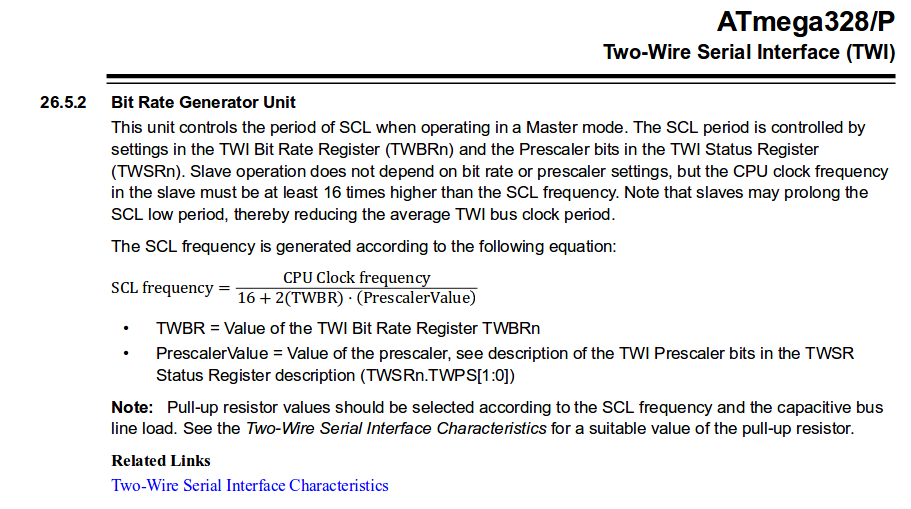i didnt have time to make my own circuit in fab lab so i started with arduino this week..
i made simple blink program:
pulled the bus lines (sda , scl) to vcc (5v) through 10k resistors.
the code:
#include <Wire.h>
char c = '1';
void setup() {
// put your setup code here, to run once:
Wire.begin();
}
void loop() {
// put your main code here, to run repeatedly:
Wire.beginTransmission(10);
Wire.write(c);
if (c == '1') //BLINK THE c
c= '0';
else
c= '1';
Wire.endTransmission();
delay(1000);
}
#include <Wire.h>
void setup() {
pinMode(13,OUTPUT);
Wire.begin(10); //i2c slave addr 10
Wire.onReceive(rcvISR);
}
void loop()
{
/* NOTHING */
}
void rcvISR(int x)
{
char c = Wire.read();
Wire.flush();
if (c == '1')
digitalWrite(13,1);
else
digitalWrite(13,0);
}
- Result:
I2c driver implementation:
i want to implement i2c driver and understand how to do it with the microcontroller..
i was going to use I2C in Attiny44A but i didnt have it with me so i choose to go with atmega328 to understand how this peripheral works…
in atmega328, the TWI peripheral is standalone not like attiny44A where ATMEL combined two wire mode (TWI/I2C) with three wire mode (SPI) into one peripheral
26.3.3 Address Packet Format:
- nine bits long
- 7 address bits
- 1 Read/Write control bit
- 1 ACK bit (slave pull this line down)
registers:
- TWBR - Two wire Baud Rate:
in this register you select baud rate. its calculated with the following equation:
F_CPU/(16+2*TWBR*4^TWPS)
where TWPS is prescaler that can be set in TWSR.
TWSR - Two wire Status resgister:
- bits [0:1] -> prescaler
- bits [3:7] -> Status bits
- bit [2] -> reserved
TWAR - Two wire Address register: this bit you load it with the address of the slave (in slave mode) so when the master sends to the node it sends ACK and can respond…
TWDR - Two wire Data register: In Transmit mode, TWDR contains the next byte to be transmitted. In Receive mode, the TWDR contains the last byte received.
TWCR - Two wire Control resgister:
- bit [7] TWINT TWI Interrupt Flag -> This bit is set by hardware when the TWI has finished its current job and expects application software response
- bit [5] TWSTA TWI START Condition -> The application writes the TWSTA bit to one when it desires to become a master on the 2-wire serial bus
- bit [4] TWSTO TWI STOP Condition -> Writing the TWSTO bit to one in Master mode will generate a STOP condition on the 2-wire serial bus
- bit [2] TWEN TWI Enable -> enables TWI operation and activates the TWI interface. When TWEN is written to one, the TWI takes control over the I/O pins connected to the SCL and SDA pins.
code:
im using ATMEL STUDIO, after compiling im uploading with AVRDUDE
/*
I2C master
sends ‘1’ and ‘0’ to slave address 10
and delay in-between (~1sec)
*/
#define F_CPU 16000000UL
#include <avr/io.h>
#include <util/delay.h>
#include <util/twi.h>
int main(void)
{
char c = '1';
TWSR &= 0xF8; //set TWPS[1:0] to 0 -> 1 prescaler value
TWBR = 0x30; //10khz @ 16mhz & 1 prescaler
while (1)
{
//start TWI:
TWCR = (1 << TWINT)|(1 << TWSTA)|(1 << TWEN); //set enable , reset int, set start
while(!(TWCR & (1 << TWINT))); //wait for int flag
if ( (TWSR & 0xf8) != TW_START)
PORTB ^= 1 << PB5; //error dbg toggle led
//send to address 10
TWDR = 10 << 1; //to send to addr 10 (address 7 bit mode + 0 write mode)
TWCR = (1 << TWINT | 1 << TWEN); //start send
while(!(TWCR & (1 << TWINT))); //wait for int flag
if ((TWSR & 0xf8) != TW_MT_SLA_ACK )
PORTB ^= 1 << PB5; //error dbg toggle led
//send data (char c)
TWDR = c;
if (c == '1')
c= '0';
else
c= '1';
TWCR = (1 << TWINT | 1 << TWEN); //start send
while(!(TWCR & (1 << TWINT))); //wait for int flag
if ((TWSR & 0xf8) != TW_MT_DATA_ACK )
PORTB ^= 1 << PB5; //error dbg toggle led
//send stop condition
TWCR = (1< < TWINT) | (1 < <TWEN) | (1 << TWSTO);
for (int i=0; i<10; i++)
_delay_ms(100);
}
}
result is same as before… :)